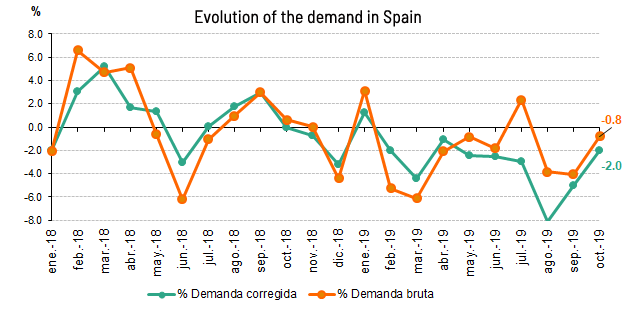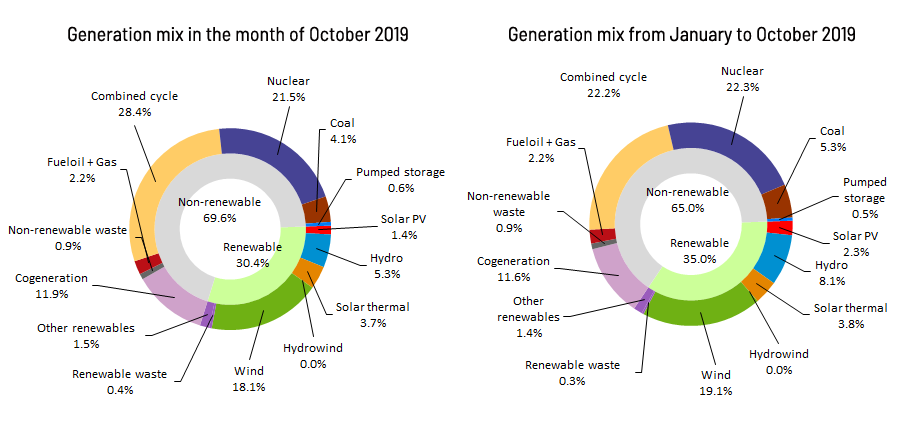We are a global operator of essential infrastructure
- 30.4% of the total generation in Spain in October came from renewable sources and 52.5% of the electricity generated was obtained using technologies which produce zero CO2 emission.
- With regard to the values registered in October 2018, electricity demand in the Balearic Islands increased 3% and the Canary Islands fell by 0.7%.

The demand for electrical energy nationwide in the month of October was estimated at 21,432 GWh, a value that is 0.7% lower than that registered in the same month last year. After having factored in the influence of seasonal and working patterns, the demand for electricity fell 1.9% compared to October 2018.

In the first ten months of 2019, the demand for electricity is estimated at 220,452 GWh, 1.8% less than in the same period in 2018. Again, after having factored in the influence of seasonal and working patterns, the demand for electricity is 2.8% lower than that registered in the same period last year.
In the month of October and according to current estimated data, generation coming from renewable energy sources represented 30.4% of the total production. In the first ten months of the year, renewable energy represented 35% of the total electricity generation mix nationwide.
52.5% of electricity generation during the month was obtained using technologies which produce zero CO2 emissions.
With information available as at the time of this press release, wind energy generation in October reached 3,809 GWh, a value 11.9% higher than in the same period last year, and accounted for 18.1% of the total production in Spain.

Demand for electrical energy in the peninsular electricity system falls by 0.8%.
Demand for electrical energy in the peninsular electricity system in the month of October is estimated at 20,133 GWh, 0.8% lower than that recorded in the same month last year. After having factored in the influence of seasonal and working patterns, the demand for electricity fell by 2% compared to October 2018.
In the first ten months of 2019, the demand for electricity on the Spanish Peninsula is estimated at 207,436 GWh, 1.9% less than in 2018. Again, after having factored in the influence of seasonal and working patterns, the demand for electricity is 3% lower than that registered in the same period last year.
During this month and according to current estimated data, 31.5% of the peninsular generation came from renewable energy sources and 54.9% was obtained using technologies which produce zero CO2 emissions. Furthermore, wind energy in October stood at 3,719 GWh, a figure that is 13.5% lower than in October last year and contributed 18.7% to the generation mix.
Demand for electrical energy increases in the Balearic Islands and drops in the Canary Islands in October
In the Balearic Islands, the demand for electricity in October is estimated at 490,338 MWh, a value that is 3% higher than that recorded in the same month last year. After having factored in the influence of seasonal and working patterns, the figure increased by 2.5% with respect to October 2018. In the first ten months of 2019, the demand on the Balearic Islands is estimated at 5,278,741 MWh, which is 0.8% more than in the same period in 2018.
Coal-fired generation, with 54.2% of the total, was the leading source of electricity generation in the Balearic Islands. Renewables and those technologies that produce zero CO2 emissions accounted for 6.9% of the total generation on the Balearic Islands.
Regarding the Canary Islands, demand for electricity is estimated at 773,435 MWh, 0.7% lower than that registered in October 2018. After having factored in the influence of seasonal and working patterns, the figure falls 1.8% compared to that of the same month last year. From January to October, demand on the Canary Islands is estimated at 7,387,891 MWh, showing an increase of 0.1% compared to the same period in 2018.
In the month of October and according to estimated data, combined cycle was the leading technology in the Canary Islands’ generation mix, with a contribution of 39.5%. Renewables and those technologies that produce zero CO2 emissions accounted for 14.5% of the generation on the Canary Islands.
Consult our Daily Balance Report for more information on the National, Peninsular, Balearic Islands and Canary Islands electricity systems as at the close of October














